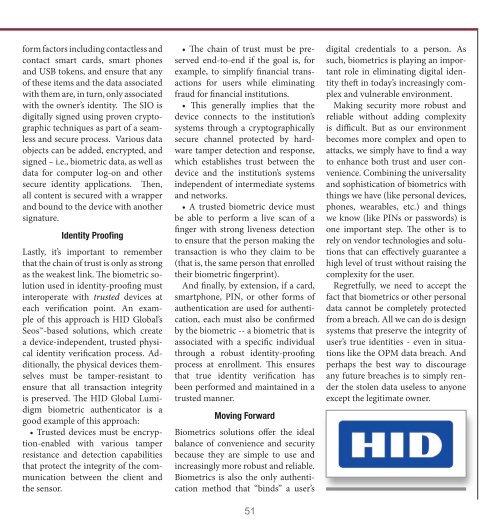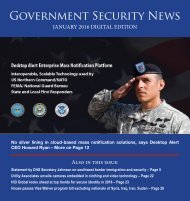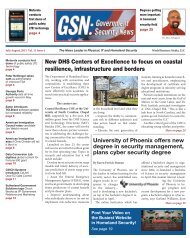GSN March 2016 Digital Edition
You also want an ePaper? Increase the reach of your titles
YUMPU automatically turns print PDFs into web optimized ePapers that Google loves.
form factors including contactless and<br />
contact smart cards, smart phones<br />
<br />
of these items and the data associated<br />
with them are, in turn, only associated<br />
with the owner’s identity. The SIO is<br />
digitally signed using proven cryptographic<br />
techniques as part of a seamless<br />
and secure process. Various data<br />
objects can be added, encrypted, and<br />
signed – i.e., biometric data, as well as<br />
data for computer log-on and other<br />
secure identity applications. Then,<br />
all content is secured with a wrapper<br />
and bound to the device with another<br />
signature.<br />
Identity Proofing<br />
Lastly, it’s important to remember<br />
that the chain of trust is only as strong<br />
as the weakest link. The biometric solution<br />
used in identity-proofing must<br />
interoperate with trusted devices at<br />
each verification point. An example<br />
of this approach is HID Global’s<br />
<br />
a device-independent, trusted physical<br />
identity verification process. Additionally,<br />
the physical devices themselves<br />
must be tamper-resistant to<br />
ensure that all transaction integrity<br />
is preserved. The HID Global Lumidigm<br />
biometric authenticator is a<br />
good example of this approach:<br />
tion-enabled<br />
with various tamper<br />
resistance and detection capabilities<br />
that protect the integrity of the communication<br />
between the client and<br />
the sensor.<br />
served<br />
end-to-end if the goal is, for<br />
example, to simplify financial transactions<br />
for users while eliminating<br />
fraud for financial institutions.<br />
<br />
device connects to the institution’s<br />
systems through a cryptographically<br />
secure channel protected by hardware<br />
tamper detection and response,<br />
which establishes trust between the<br />
device and the institution’s systems<br />
independent of intermediate systems<br />
and networks.<br />
<br />
be able to perform a live scan of a<br />
finger with strong liveness detection<br />
to ensure that the person making the<br />
transaction is who they claim to be<br />
(that is, the same person that enrolled<br />
<br />
And finally, by extension, if a card,<br />
<br />
authentication are used for authentication,<br />
each must also be confirmed<br />
by the biometric -- a biometric that is<br />
associated with a specific individual<br />
through a robust identity-proofing<br />
process at enrollment. This ensures<br />
that true identity verification has<br />
been performed and maintained in a<br />
trusted manner.<br />
Moving Forward<br />
<br />
balance of convenience and security<br />
because they are simple to use and<br />
increasingly more robust and reliable.<br />
cation<br />
method that “binds” a user’s<br />
51<br />
digital credentials to a person. As<br />
such, biometrics is playing an important<br />
role in eliminating digital identity<br />
theft in today’s increasingly complex<br />
and vulnerable environment.<br />
Making security more robust and<br />
reliable without adding complexity<br />
<br />
becomes more complex and open to<br />
attacks, we simply have to find a way<br />
to enhance both trust and user convenience.<br />
Combining the universality<br />
and sophistication of biometrics with<br />
things we have (like personal devices,<br />
<br />
<br />
one important step. The other is to<br />
rely on vendor technologies and solutions<br />
that can effectively guarantee a<br />
high level of trust without raising the<br />
complexity for the user.<br />
Regretfully, we need to accept the<br />
fact that biometrics or other personal<br />
data cannot be completely protected<br />
from a breach. All we can do is design<br />
systems that preserve the integrity of<br />
user’s true identities - even in situa-<br />
<br />
perhaps the best way to discourage<br />
any future breaches is to simply render<br />
the stolen data useless to anyone<br />
except the legitimate owner.
















